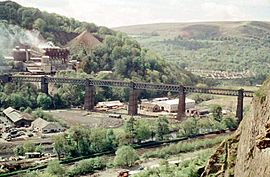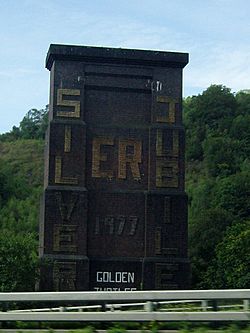Walnut Tree Viaduct facts for kids
Quick facts for kids Walnut Tree Viaduct |
|
|---|---|

The Walnut Tree Viaduct prior to demolition in the 1960s
|
|
| Coordinates | 51°32′14″N 3°15′42″W / 51.53722°N 3.26167°W |
| Carries | Barry Railway |
| Crosses | River Taff |
| Locale | Taffs Well, Cardiff, South Wales |
| Owner | Barry Railway Great Western Railway British Railways Cardiff Council |
| Preceded by | Walnut Tree Tunnel 490 yards (450 m) |
| Followed by | Penrhos Lower Junction |
| Characteristics | |
| Material | Brick columns Steel lattice girders spans |
| Total length | 1,548 feet (472 m) |
| Height | 120 feet (37 m) |
| Number of spans | 7 |
| History | |
| Architect | Sir James Szlumper |
| Designer | Sir James Szlumper |
| Engineering design by | Sir James Szlumper |
| Construction begin | 1901 |
| Construction end | 1901 |
| Closed | 1969 |
The Walnut Tree Viaduct was a large railway bridge in Taffs Well, South Wales. It was built to carry the Barry Railway trains over a narrow valley. This valley had the River Taff, the Taff Vale Railway, and the Cardiff Railway. The viaduct was taken down in 1969. Today, only two of its support pillars can be seen from the A470 road.
Contents
Why Was the Viaduct Built?
Coal and Railways in South Wales
During the time when lots of coal was dug up in South Wales, many railways were built. These railways helped move the coal from the mines. The Taff Vale Railway (TVR) controlled most of the coal transport to Cardiff Docks. Mine owners wanted other railway companies to help. They hoped this would make shipping faster and cheaper.
Problems with Existing Railways
By 1880, the TVR and the Rhymney Railway (RR) were very busy. There was too much coal traffic. A group of mine owners and business people, led by David Davies, faced two main problems:
- Taff Vale Railway: This railway had the main tracks. But south of Pontypridd railway station, there was only one double track. It could not be made bigger because of the difficult landscape. This caused delays for trains carrying coal.
- Cardiff Docks: These docks were built by Lord Bute. They were good for his coal, but not big enough for all the new mines. Also, the docks in Cardiff had muddy areas and tides that made it hard for ships.
The Idea for Barry Railway
David Davies suggested building a new railway line. This line would go to Barry, where a new dock could be built. The Barry docks would not have the same problems with mud or tides. This new route would be better and faster for moving coal than going to Cardiff.
The plan for the Barry Dock and Railway was first suggested in 1883. It was stopped by people who owned the Cardiff Docks and the Taff Vale Railway. But the plan was brought back the next year. A special law was passed on August 14, 1884. This law allowed the building of a dock and railway between Barry and Barry Island. The company's name changed to the Barry Railway Company in 1891.
The Llanbradach Branch Line
Connecting to More Coal Mines
By 1889, the main line of the Barry Railway connected Barry Docks to Hafod Junction. This was near Trehafod railway station in the Rhondda Valley. But David Davies also wanted to reach the Rhymney Valley. He wanted to get to the industrial town of Dowlais, near Merthyr Tydfil. So, he planned a direct branch line to Llanbradach. This line would start from Tynycaeau Junction on the main line.
Designing the New Line
Sir James Szlumper, the Chief Engineer, designed this new line. It was called the Llanbradach branch. It would go from Tynycaeau Junction near St Fagans to a connection with the Brecon and Merthyr Railway (BMR) at Llanbradach. This connection was first called Barry Junction (BMR). Later, it was known as Duffryn Isaf Junction. There were no stations on this line. This allowed freight trains to run without stopping, carrying coal as fast as possible.
The Walnut Tree Viaduct's Location
The line passed through the Lesser Garth hill using the Walnut Tree Tunnel (490 yards (450 m) long). After the tunnel, the line curved right. It then reached the viaduct. This bridge crossed the River Taff valley at a very narrow spot called Walnut Tree. The viaduct had to be very tall. It also had to curve at its north-eastern end. This curve allowed the line to go onto a rock shelf on the eastern hillside. After that, the railway climbed the eastern hillside. It then went north-east to connect with the Rhymney Railway at Penrhos Lower Junction. This gave access to Caerphilly.
Other viaducts were also built on this extension. These included the Penrhos Viaduct and the Penyrheol Viaduct. Finally, the line went around the west side of Caerphilly. It crossed the Rhymney valley using the Llanbradach Viaduct. This helped make the slope easier for trains going to the BMR junction.
How the Viaduct Was Built
Building Challenges
Sir James Szlumper faced similar problems to those of Charles Liddell. Liddell built the Crumlin Viaduct over the Ebbw River. Szlumper studied that bridge and learned some things:
- The viaduct needed to be very tall. This caused problems with its structure and with strong winds. The valley acted like a funnel, making the wind faster.
- There were not enough good building materials nearby. Everything had to be brought in from other places.
- A bridge made of stone would not be stable. It would also need a lot of repairs. A thick stone bridge would also make the wind around the tracks stronger. This could be dangerous for people on the train.
The Final Design
Because of these challenges, Szlumper suggested using steel lattice girders for the spans. These would sit on top of brick support columns. The viaduct was built in less than 12 months and opened in 1901. It was 120 feet (37 m) high at its tallest point. The seven spans made the bridge 1,548 feet (472 m) long. It curved slightly at its western end to connect with the railway line.
When the Viaduct Closed
The Llanbradach branch line was used for a short time. The Great Western Railway took it out of service in the early 1930s. All three viaducts on that part of the line were taken down and sold for scrap by 1937. Today, only one brick arch remains where the Llanbradach Viaduct once stood.
Later, the line was called the 'Penrhos Branch'. After the railways became owned by the government, it was controlled by British Railways. In 1963, a fire destroyed a signal box. British Railways decided not to rebuild it. The remaining part of the line was used as a long siding for a quarry. The last train crossed the Walnut Tree Viaduct in 1967. The rest of the line was taken up in 1969.
Demolition of the Viaduct
The Welsh Office and Cardiff Council planned to improve the A470 road. This meant that two of the Walnut Tree Viaduct's brick pillars were in the way. British Railways agreed to close the remaining line. Contractors started taking down the Walnut Tree Viaduct in 1969. It took longer than expected because most of the pillars had to be taken down by hand. This was due to the busy valley below. The work was finished by 1974.
What Remains Today?
Today, only a few parts of the Walnut Tree Viaduct are left. These include the tunnel support, an angled pillar, and the Taff Bank pier. You can see them from the village and the A470 road. In 1977, the Taff Bank pier was used to display a message. It celebrated the Silver Jubilee of Elizabeth II, and the words can still be seen today. Some parts of the old railway track are now part of the Taff Trail, a path for walking and cycling.
Images for kids




